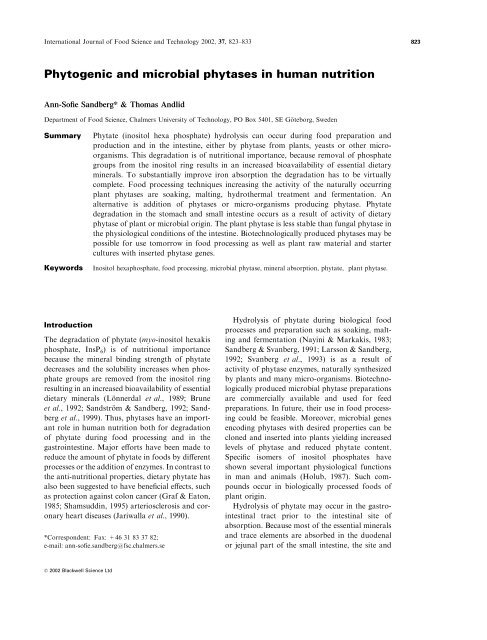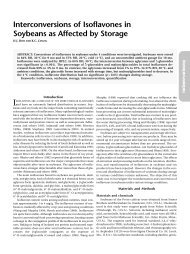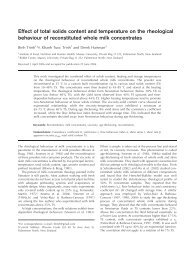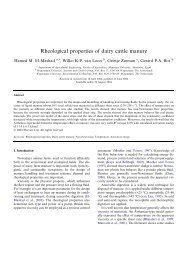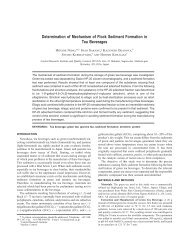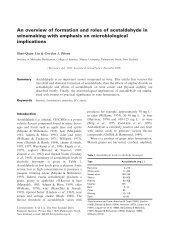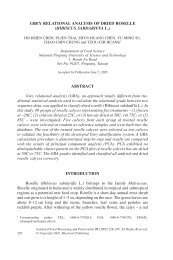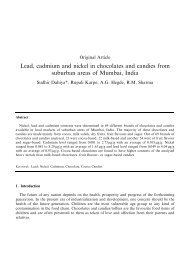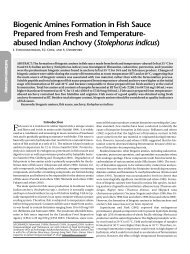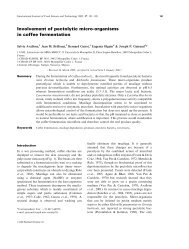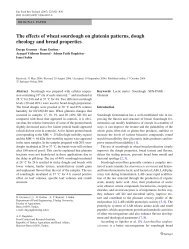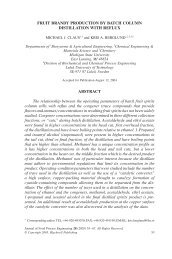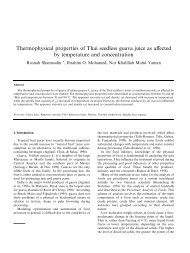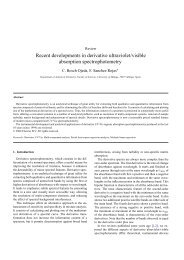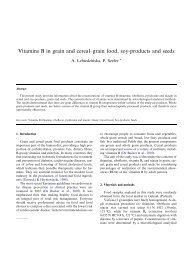Phytogenic and microbial phytases in human nutrition
Phytogenic and microbial phytases in human nutrition
Phytogenic and microbial phytases in human nutrition
You also want an ePaper? Increase the reach of your titles
YUMPU automatically turns print PDFs into web optimized ePapers that Google loves.
International Journal of Food Science <strong>and</strong> Technology 2002, 37, 823–833 823<br />
<strong>Phytogenic</strong> <strong>and</strong> <strong>microbial</strong> <strong>phytases</strong> <strong>in</strong> <strong>human</strong> <strong>nutrition</strong><br />
Ann-Sofie S<strong>and</strong>berg* & Thomas Andlid<br />
Department of Food Science, Chalmers University of Technology, PO Box 5401, SE Go¨ teborg, Sweden<br />
Summary Phytate (<strong>in</strong>ositol hexa phosphate) hydrolysis can occur dur<strong>in</strong>g food preparation <strong>and</strong><br />
production <strong>and</strong> <strong>in</strong> the <strong>in</strong>test<strong>in</strong>e, either by phytase from plants, yeasts or other microorganisms.<br />
This degradation is of <strong>nutrition</strong>al importance, because removal of phosphate<br />
groups from the <strong>in</strong>ositol r<strong>in</strong>g results <strong>in</strong> an <strong>in</strong>creased bioavailability of essential dietary<br />
m<strong>in</strong>erals. To substantially improve iron absorption the degradation has to be virtually<br />
complete. Food process<strong>in</strong>g techniques <strong>in</strong>creas<strong>in</strong>g the activity of the naturally occurr<strong>in</strong>g<br />
plant <strong>phytases</strong> are soak<strong>in</strong>g, malt<strong>in</strong>g, hydrothermal treatment <strong>and</strong> fermentation. An<br />
alternative is addition of <strong>phytases</strong> or micro-organisms produc<strong>in</strong>g phytase. Phytate<br />
degradation <strong>in</strong> the stomach <strong>and</strong> small <strong>in</strong>test<strong>in</strong>e occurs as a result of activity of dietary<br />
phytase of plant or <strong>microbial</strong> orig<strong>in</strong>. The plant phytase is less stable than fungal phytase <strong>in</strong><br />
the physiological conditions of the <strong>in</strong>test<strong>in</strong>e. Biotechnologically produced <strong>phytases</strong> may be<br />
possible for use tomorrow <strong>in</strong> food process<strong>in</strong>g as well as plant raw material <strong>and</strong> starter<br />
cultures with <strong>in</strong>serted phytase genes.<br />
Keywords Inositol hexaphosphate, food process<strong>in</strong>g, <strong>microbial</strong> phytase, m<strong>in</strong>eral absorption, phytate, plant phytase.<br />
Introduction<br />
The degradation of phytate (myo-<strong>in</strong>ositol hexakis<br />
phosphate, InsP 6) is of <strong>nutrition</strong>al importance<br />
because the m<strong>in</strong>eral b<strong>in</strong>d<strong>in</strong>g strength of phytate<br />
decreases <strong>and</strong> the solubility <strong>in</strong>creases when phosphate<br />
groups are removed from the <strong>in</strong>ositol r<strong>in</strong>g<br />
result<strong>in</strong>g <strong>in</strong> an <strong>in</strong>creased bioavailability of essential<br />
dietary m<strong>in</strong>erals (Lo¨ nnerdal et al., 1989; Brune<br />
et al., 1992; S<strong>and</strong>stro¨ m & S<strong>and</strong>berg, 1992; S<strong>and</strong>berg<br />
et al., 1999). Thus, <strong>phytases</strong> have an important<br />
role <strong>in</strong> <strong>human</strong> <strong>nutrition</strong> both for degradation<br />
of phytate dur<strong>in</strong>g food process<strong>in</strong>g <strong>and</strong> <strong>in</strong> the<br />
gastro<strong>in</strong>test<strong>in</strong>e. Major efforts have been made to<br />
reduce the amount of phytate <strong>in</strong> foods by different<br />
processes or the addition of enzymes. In contrast to<br />
the anti-<strong>nutrition</strong>al properties, dietary phytate has<br />
also been suggested to have beneficial effects, such<br />
as protection aga<strong>in</strong>st colon cancer (Graf & Eaton,<br />
1985; Shamsudd<strong>in</strong>, 1995) arteriosclerosis <strong>and</strong> coronary<br />
heart diseases (Jariwalla et al., 1990).<br />
*Correspondent: Fax: +46 31 83 37 82;<br />
e-mail: ann-sofie.s<strong>and</strong>berg@fsc.chalmers.se<br />
Ó 2002 Blackwell Science Ltd<br />
Hydrolysis of phytate dur<strong>in</strong>g biological food<br />
processes <strong>and</strong> preparation such as soak<strong>in</strong>g, malt<strong>in</strong>g<br />
<strong>and</strong> fermentation (Nay<strong>in</strong>i & Markakis, 1983;<br />
S<strong>and</strong>berg & Svanberg, 1991; Larsson & S<strong>and</strong>berg,<br />
1992; Svanberg et al., 1993) is as a result of<br />
activity of phytase enzymes, naturally synthesized<br />
by plants <strong>and</strong> many micro-organisms. Biotechnologically<br />
produced <strong>microbial</strong> phytase preparations<br />
are commercially available <strong>and</strong> used for feed<br />
preparations. In future, their use <strong>in</strong> food process<strong>in</strong>g<br />
could be feasible. Moreover, <strong>microbial</strong> genes<br />
encod<strong>in</strong>g <strong>phytases</strong> with desired properties can be<br />
cloned <strong>and</strong> <strong>in</strong>serted <strong>in</strong>to plants yield<strong>in</strong>g <strong>in</strong>creased<br />
levels of phytase <strong>and</strong> reduced phytate content.<br />
Specific isomers of <strong>in</strong>ositol phosphates have<br />
shown several important physiological functions<br />
<strong>in</strong> man <strong>and</strong> animals (Holub, 1987). Such compounds<br />
occur <strong>in</strong> biologically processed foods of<br />
plant orig<strong>in</strong>.<br />
Hydrolysis of phytate may occur <strong>in</strong> the gastro<strong>in</strong>test<strong>in</strong>al<br />
tract prior to the <strong>in</strong>test<strong>in</strong>al site of<br />
absorption. Because most of the essential m<strong>in</strong>erals<br />
<strong>and</strong> trace elements are absorbed <strong>in</strong> the duodenal<br />
or jejunal part of the small <strong>in</strong>test<strong>in</strong>e, the site <strong>and</strong>
824<br />
Degradation of phytate A.-S. S<strong>and</strong>berg & T. Andlid<br />
degree of phytate degradation can affect the<br />
<strong>nutrition</strong>al value of a high phytate diet. Furthermore,<br />
enzymatic hydrolysis of phytate <strong>in</strong> the<br />
gastro<strong>in</strong>test<strong>in</strong>e leads to formation of specific<br />
isomers of <strong>in</strong>ositol phosphates. If physiologically<br />
active lower <strong>in</strong>ositol phosphates, formed dur<strong>in</strong>g<br />
food process<strong>in</strong>g, or degradation <strong>in</strong> the gastro<strong>in</strong>test<strong>in</strong>e<br />
or precursors to these are absorbed <strong>in</strong> the<br />
alimentary tract of <strong>human</strong>s it may have important<br />
health implications (Holub, 1987).<br />
Enzymatic hydrolysis of phytate<br />
Phytases (InsP 6-phosphohydrolases) are by def<strong>in</strong>ition<br />
enzymes able to hydrolyse InsP 6 to InsP 5<br />
<strong>and</strong> <strong>in</strong>organic phosphate (Pi). Typically, <strong>phytases</strong><br />
are not specific for InsP 6, lead<strong>in</strong>g to further<br />
hydrolysis to myo-<strong>in</strong>ositol via <strong>in</strong>termediate myo<strong>in</strong>ositol<br />
phosphates (penta- to monophosphates)<br />
(Cosgrove, 1966). Phytases constitutes a subgroup<br />
of the family of acid phosphatases. Those that<br />
exhibit the ability of hydrolyse InsP 6 can be<br />
considered to be <strong>phytases</strong> (Gibson & Ullah, 1990).<br />
Phytate is one of the most abundant organic<br />
phosphorous compound <strong>in</strong> nature. Hence, it<br />
follows that the ability to synthesize <strong>phytases</strong> is<br />
widely distributed among organisms, <strong>in</strong>clud<strong>in</strong>g<br />
plants, micro-organisms <strong>and</strong> animal cells. With<br />
respect to the position for <strong>in</strong>itial hydrolysis, two<br />
types of <strong>phytases</strong>, 3- <strong>and</strong> 6-<strong>phytases</strong>, have been<br />
recognized as start<strong>in</strong>g the dephosphorylation of<br />
InsP 6 at position d-3 or l-6 of the <strong>in</strong>ositol r<strong>in</strong>g.<br />
The 3-<strong>phytases</strong> (EC 3.1.3.8) have been found to<br />
dom<strong>in</strong>ate among micro-organisms while 6-phytase<br />
(EC 3.1.3.26) (4-phytase assum<strong>in</strong>g d-configuration)<br />
has been considered to be characteristic of<br />
the seeds of higher plants (Cosgrove, 1980). This<br />
is, however, not a general rule. For <strong>in</strong>stance,<br />
Escherichia coli has been shown to produce a<br />
6-phytase <strong>and</strong> soybean a 3-phytase. Depend<strong>in</strong>g on<br />
the type of food process or whether a phytase is<br />
expected to be active <strong>in</strong> the gut, different properties<br />
should be considered <strong>in</strong> the search for optimal<br />
enzyme. These may <strong>in</strong>clude stability at low pH <strong>and</strong><br />
at high temperature, level of glycosylation, resistance<br />
aga<strong>in</strong>st digestive proteolytic enzymes, high<br />
specific activity, suitable pH- <strong>and</strong> temperature<br />
optima, high level of expression, easy cultivation<br />
(of phytase produc<strong>in</strong>g organism) <strong>and</strong> purification,<br />
extracellular phytase, nonallergenic, <strong>and</strong> nontoxic.<br />
Sources of phytase<br />
Plant <strong>phytases</strong><br />
Plants may express high levels of <strong>phytases</strong> <strong>in</strong><br />
storage compartments such as seeds for the purpose<br />
of utiliz<strong>in</strong>g Pi <strong>and</strong> energy required for growth<br />
of the germ<strong>in</strong>at<strong>in</strong>g plant. Phytase enzymes have<br />
been isolated <strong>and</strong> characterized from a number of<br />
plant sources; the <strong>in</strong>itial preparation of phytase<br />
made from rice bran (Suzuki et al., 1907). It is,<br />
however, only recently that some <strong>phytases</strong> have<br />
been isolated <strong>and</strong> purified to homogenity (Gre<strong>in</strong>er<br />
et al., 1993, 1997, 1998; Konietzny et al., 1994;<br />
Gre<strong>in</strong>er & Larsson-Alm<strong>in</strong>ger, 1999).<br />
Consider<strong>in</strong>g the <strong>in</strong> vitro degradation of InsP 6 by<br />
plant <strong>phytases</strong> such as wheat phytase (Phillippy,<br />
1989; Tu¨ rk et al., 1996) <strong>and</strong> the phytase from rye<br />
(Gre<strong>in</strong>er et al., 1998), spelt (Konietzny et al., 1994)<br />
<strong>and</strong> barley (S<strong>and</strong>berg, 2002) are reported to be 6(4)<strong>phytases</strong>.<br />
The major InsP5 <strong>in</strong> raw soybean was dl-<br />
Ins(1,2,4,5,6)P 5 <strong>and</strong> thus soybean phytase seems to<br />
be a 3-phytase (Phillippy & Bl<strong>and</strong>, 1988). Another<br />
legum<strong>in</strong>ous plant, pea, was also found to have a<br />
degradation pathway of InsP 6 dissimilar to that of<br />
cereals (Skoglund et al., 1997a).<br />
The isomeric pattern dur<strong>in</strong>g degradation of<br />
InsP6 <strong>in</strong> oats, rye <strong>and</strong> barley were found to be<br />
similar to that formed by hydrolysis by wheat<br />
phytase (Skoglund et al., 1997a). The same InsP 6<br />
degradation pathway may be assumed <strong>in</strong> these<br />
cereals.<br />
Microbial <strong>phytases</strong><br />
Because InsP6 seems to be present <strong>in</strong> most liv<strong>in</strong>g<br />
cells, it follows that <strong>in</strong>tracellular InsP6 hydrolys<strong>in</strong>g<br />
enzymes must be present <strong>in</strong> most micro-organisms.<br />
However, for production of <strong>microbial</strong> <strong>phytases</strong> for<br />
food applications or fermentations with live phytase<br />
express<strong>in</strong>g micro-organisms, the extracellular<br />
<strong>phytases</strong> are the most important. These are InsP 6<br />
hydrolys<strong>in</strong>g enzymes that are secreted to the<br />
surround<strong>in</strong>gs, aimed for efficient degradation of<br />
phytate as a source of phosphorous <strong>and</strong> sometimes<br />
energy required for growth. Obviously, the<br />
advantage with extracellular <strong>phytases</strong> are easy<br />
purification <strong>and</strong> the fact that dur<strong>in</strong>g food process<strong>in</strong>g<br />
the substrate <strong>and</strong> enzyme must meet. The<br />
secretory <strong>microbial</strong> <strong>phytases</strong> are sometimes, as <strong>in</strong><br />
International Journal of Food Science <strong>and</strong> Technology 2002, 37, 823–833 Ó 2002 Blackwell Science Ltd
the case of common Baker’s yeast, fairly unspecific<br />
<strong>and</strong> may degrade other organic phosphorous<br />
sources <strong>in</strong> addition to InsP 6 (Nay<strong>in</strong>i & Markakis,<br />
1983). Regard<strong>in</strong>g the less <strong>in</strong>vestigated <strong>in</strong>tracellular<br />
InsP6 hydrolys<strong>in</strong>g enzymes it is likely to f<strong>in</strong>d<br />
enzymes with a different position specificity.<br />
Fungal <strong>phytases</strong><br />
Fungi are an important source of <strong>phytases</strong>. Among<br />
mycelia fungi, the most explored genus is Aspergillus<br />
from which the commercially produced <strong>phytases</strong><br />
orig<strong>in</strong>ate. In particular the species A. niger,<br />
A. ficuum <strong>and</strong> A. fumigatus have been <strong>in</strong>vestigated.<br />
Genes have been cloned <strong>and</strong> research has been<br />
undertaken to further improve the Aspergillus<br />
enzymes by prote<strong>in</strong> eng<strong>in</strong>eer<strong>in</strong>g (Wyss et al.,<br />
1999). For <strong>in</strong>stance, elegant work by (Lehmann<br />
et al., 2000) have resulted <strong>in</strong> improved thermal<br />
stability by am<strong>in</strong>o acid substitutions. However,<br />
these enzymes are as yet not classed as food grade.<br />
Also <strong>in</strong> yeasts, the ability to synthesize <strong>and</strong> secret<br />
<strong>phytases</strong> seems to be almost universal. All yeasts<br />
exam<strong>in</strong>ed <strong>in</strong> our laboratory showed phytase activity,<br />
as determ<strong>in</strong>ed by growth <strong>in</strong> medium conta<strong>in</strong><strong>in</strong>g<br />
InsP 6 as the sole phosphorus source followed by<br />
high-pressure liquid chromatography (HPLC)<br />
analysis of extracellular InsP 6 degradation. The<br />
yeasts tested <strong>in</strong>clude more than 10stra<strong>in</strong>s of<br />
Saccharomyces cerevisiae from various sources,<br />
different stra<strong>in</strong>s of Debaryomyces hansenii, Rhodotorula<br />
rubra, Rh. glut<strong>in</strong>is, S. boulardii, <strong>and</strong> several<br />
tropical species such as Metschmikowia lochheadii,<br />
C<strong>and</strong>ida drosophilae <strong>and</strong> C<strong>and</strong>ida tolerans. Common<br />
Baker’s yeast would be particularly attractive<br />
because of its generally regarded as safe (GRAS)<br />
status. However, data show that for high yeast<br />
phytase activity to take place, conditions must<br />
favour the expression of the <strong>phytases</strong> (Andlid,<br />
2000). Naturally, among the approximately 1000<br />
species of described yeasts, the vast majority<br />
rema<strong>in</strong>s to be exam<strong>in</strong>ed regard<strong>in</strong>g <strong>phytases</strong>.<br />
Bacterial <strong>phytases</strong><br />
Several bacteria has been shown to be able to<br />
express phytase activity. Examples are E. coli,<br />
Bacillus subtilis, Klebsiella terr<strong>in</strong>ga, Pseudomonas<br />
spp. (Gre<strong>in</strong>er et al., 1993, 1997; Richardson &<br />
Hadobas, 1997; Kerovuo et al., 1998). Some of<br />
these bacteria can degrade phytate dur<strong>in</strong>g growth<br />
<strong>and</strong> hence produce extracellular <strong>phytases</strong>. How-<br />
Degradation of phytate A.-S. S<strong>and</strong>berg & T. Andlid 825<br />
ever, <strong>in</strong> the important group of lactic acid bacteria<br />
(LAB) conclusive evidence for extracellular phytase<br />
activity are lack<strong>in</strong>g (Fredrikson et al., 2002).<br />
Studies of <strong>in</strong> vitro degradation of InsP 6 by bacterial<br />
phytase shows that <strong>phytases</strong> synthesized by<br />
K. terrigena (Gre<strong>in</strong>er et al., 1997) <strong>and</strong> S. cerevisae<br />
(Tu¨ rk et al., 2000) belong to the 3-<strong>phytases</strong><br />
whereas <strong>phytases</strong> of E. coli (Gre<strong>in</strong>er et al., 1993)<br />
belong to the 6-<strong>phytases</strong>. Naturally, most bacteria<br />
rema<strong>in</strong>s to be <strong>in</strong>vestigated for phytase activity.<br />
Enzymatic degradation of phytate<br />
dur<strong>in</strong>g food process<strong>in</strong>g<br />
Phytate hydrolysis can occur dur<strong>in</strong>g food preparation<br />
<strong>and</strong> production, either by phytase from<br />
plants, yeasts or other micro-organisms. Biological<br />
process<strong>in</strong>g techniques, which <strong>in</strong>crease the<br />
activity of native enzymes of cereals <strong>and</strong> legumes<br />
are soak<strong>in</strong>g, malt<strong>in</strong>g, hydrothermal process<strong>in</strong>g<br />
<strong>and</strong> lactic fermentation. Dur<strong>in</strong>g the germ<strong>in</strong>ation<br />
step of the malt<strong>in</strong>g process, enzymes are synthesized<br />
or activated. Lactic fermentation leads to<br />
lower<strong>in</strong>g of pH as a consequence of bacterial<br />
production of organic acids, ma<strong>in</strong>ly lactic <strong>and</strong><br />
acetic acid, which is favourable for cereal phytase<br />
activity. In addition, starter cultures may also be<br />
selected <strong>in</strong> future for high phytase activity dur<strong>in</strong>g<br />
the fermentation process. Phytase preparations<br />
can also be added <strong>in</strong> the food process. To optimize<br />
the food process for <strong>in</strong>creased m<strong>in</strong>eral bioavailability<br />
by phytate degradation, it is essential to<br />
know optimal conditions for the <strong>phytases</strong>, responsible<br />
for phytate degradation <strong>in</strong> the process.<br />
Naturally, there are differences <strong>in</strong> optimal conditions<br />
for phytase activity between different plant<br />
species. Moreover, except phytate, InsP5 has been<br />
identified as <strong>in</strong>hibitor of iron <strong>and</strong> z<strong>in</strong>c absorption<br />
<strong>in</strong> <strong>human</strong> <strong>and</strong> animal studies (Lo¨ nnerdal et al.,<br />
1989; S<strong>and</strong>stro¨ m & S<strong>and</strong>berg, 1992; S<strong>and</strong>berg<br />
et al., 1999). No difference between various isomers<br />
of <strong>in</strong>ositol phosphates on iron uptake <strong>in</strong> vitro<br />
<strong>in</strong> CaCo 2 cells was shown (Skoglund et al., 1999).<br />
Recently <strong>in</strong>dications were found that InsP 4 <strong>and</strong><br />
InsP3 contribute to the negative effect on iron<br />
absorption by <strong>in</strong>teract<strong>in</strong>g with the higher phosphorylated<br />
<strong>in</strong>ositol phosphates. These f<strong>in</strong>d<strong>in</strong>gs<br />
suggest that phytate degradation of not only<br />
InsP 5 <strong>and</strong> InsP 6, but also degradation of InsP 3<br />
<strong>and</strong> InsP 4 are favourable for improvement of iron<br />
Ó 2002 Blackwell Science Ltd International Journal of Food Science <strong>and</strong> Technology 2002, 37, 823–833
826<br />
Degradation of phytate A.-S. S<strong>and</strong>berg & T. Andlid<br />
absorption from cereal <strong>and</strong> soy products (S<strong>and</strong>berg<br />
et al., 1999). This is probably also true for<br />
z<strong>in</strong>c absorption as a strong negative correlation<br />
was found between z<strong>in</strong>c absorption <strong>and</strong> the sum of<br />
native InsP3 through InsP6 from cereal <strong>and</strong> legume<br />
meals (S<strong>and</strong>berg, 1991).<br />
Soak<strong>in</strong>g, malt<strong>in</strong>g <strong>and</strong> hydrothermal process<strong>in</strong>g<br />
Soak<strong>in</strong>g of wheat bran, whole wheatflour <strong>and</strong> rye<br />
flour at optimal conditions for wheat phytase<br />
activity (pH 4.5–5, 55 °C) resulted <strong>in</strong> complete<br />
phytate hydrolysis (Mellanby, 1950; S<strong>and</strong>berg &<br />
Svanberg, 1991) <strong>and</strong> to a marked <strong>in</strong>crease <strong>in</strong><br />
<strong>in</strong> vitro iron availability. S<strong>and</strong>berg & Svanberg<br />
(1991) found that the InsP 6 <strong>and</strong> InsP 5 content<br />
must be reduced to levels beyond 0.5 lmol g )1 to<br />
give the strong <strong>in</strong>crease <strong>in</strong> iron solubility at<br />
simulated physiological conditions, when no<br />
enhancers were present.<br />
Malt<strong>in</strong>g is a process dur<strong>in</strong>g which the whole<br />
gra<strong>in</strong> is soaked <strong>and</strong> then germ<strong>in</strong>ated. The amount<br />
of phytate <strong>in</strong> malted gra<strong>in</strong>s of wheat, rye <strong>and</strong> oats<br />
<strong>in</strong>tended for the production of flour (germ<strong>in</strong>ated<br />
3 days at 15 °C sprout length 10mm) was only<br />
reduced slightly or not at all. However, when the<br />
malted cereals were ground <strong>and</strong> soaked at optimal<br />
conditions for wheat phytase there was a complete<br />
degradation of phytate (Larsson & S<strong>and</strong>berg,<br />
1992), except for oats, which under the conditions<br />
studied had a low phytase activity. By germ<strong>in</strong>ation<br />
of oats for 5 days at 11 °C followed by <strong>in</strong>cubation<br />
at 37–40 °C, phytate content of oats was reduced<br />
by 98% (to
oat <strong>and</strong> rye bran bread made with 10% sourdough<br />
(pH 4.6) or <strong>in</strong> the breads <strong>in</strong> which the pH had been<br />
adjusted <strong>in</strong> the mild scald<strong>in</strong>g with lactic acid,<br />
result<strong>in</strong>g <strong>in</strong> a pH between 4.4 <strong>and</strong> 5.1 <strong>in</strong> both dough<br />
<strong>and</strong> bread. The percentage of iron absorption from<br />
bread meals conta<strong>in</strong><strong>in</strong>g this sourdough fermented<br />
bread was similar to that of white wheat bread not<br />
conta<strong>in</strong><strong>in</strong>g <strong>in</strong>hibitory factors (Brune et al., 1992).<br />
Consequently, the amounts of iron absorbed from<br />
wholemeal bread with its high content of iron,<br />
would be greater than that from white bread,<br />
provided the fermentation is optimized.<br />
In another study of bread-mak<strong>in</strong>g, Tu¨ rk &<br />
S<strong>and</strong>berg (1992) <strong>in</strong>vestigated the effect of different<br />
additives to the dough. Bread was made us<strong>in</strong>g<br />
whole wheat flour <strong>and</strong> flour of 60% extraction<br />
rate. Addition of milk to the dough <strong>in</strong>hibited<br />
enzymatic phytate hydrolysis result<strong>in</strong>g <strong>in</strong><br />
depressed <strong>human</strong> iron absorption from the bread<br />
(Hallberg et al., 1991). Fermented milk did not<br />
significantly <strong>in</strong>hibit enzymatic hydrolysis dur<strong>in</strong>g<br />
fermentation, probably depend<strong>in</strong>g on the presence<br />
of lactic acid lower<strong>in</strong>g the pH (Tu¨ rk & S<strong>and</strong>berg,<br />
1992). Addition of acetic acid or l<strong>in</strong>gonberries to<br />
the dough <strong>in</strong>creased the phytate reduction to 96<br />
<strong>and</strong> 83%, respectively, compared with 55% <strong>in</strong><br />
control bread without additives (Tu¨ rk et al.,<br />
1996). The pH of the doughs with 96% reduction<br />
was between 4.5 <strong>and</strong> 5. This degradation was<br />
ma<strong>in</strong>ly a result of the activity of phytase <strong>in</strong> the<br />
flour whereas the contribution of phytase activity<br />
from Baker’s yeast dur<strong>in</strong>g bread fermentation was<br />
very small. It was concluded that conditions<br />
dur<strong>in</strong>g bread fermentation disfavour yeast phytase<br />
expression (Tu¨ rk et al., 2000).<br />
Addition of enzymes<br />
An alternative to activation of the <strong>in</strong>tr<strong>in</strong>sic<br />
enzymes of foods is the addition of phytase dur<strong>in</strong>g<br />
food process<strong>in</strong>g. Microbial phytase enzyme preparations<br />
are now available commercially mak<strong>in</strong>g<br />
their use <strong>in</strong> food process<strong>in</strong>g technically feasible.<br />
Moreover, the phytase encod<strong>in</strong>g gene A. niger<br />
(phyA) has been cloned <strong>and</strong> over-expressed<br />
result<strong>in</strong>g <strong>in</strong> a more than tenfold <strong>in</strong>crease <strong>in</strong><br />
phytase activity per biomass unit compared with<br />
the wild-type stra<strong>in</strong> (Hart<strong>in</strong>gsveldt et al., 1993).<br />
Phytase from A. niger 1500 PU g )1 flour (one<br />
phytase unit, PU, is the amount of enzyme<br />
Degradation of phytate A.-S. S<strong>and</strong>berg & T. Andlid 827<br />
which liberates under st<strong>and</strong>ard conditions, pH<br />
5.0, 37 °C, 1 nmol of Pi from sodium phytate<br />
dur<strong>in</strong>g 1 m<strong>in</strong>) was added to the doughs prepared<br />
us<strong>in</strong>g whole wheatflour <strong>and</strong> flour of 60%<br />
extraction rate. The phytate hydrolysis <strong>in</strong> the<br />
dough was, however, not complete (maximum<br />
88% hydrolysis), unless the pH was lowered to<br />
3.5 which is close to the lower pH optimum<br />
(Tu¨ rk et al., 1996). A. niger phytase, therefore,<br />
may be useful <strong>in</strong> the production of lactic acid<br />
fermented cereals <strong>and</strong> legumes (which normally<br />
have a low pH value) aimed at high m<strong>in</strong>eral<br />
availability. A very effective phytate degradation<br />
was achieved by add<strong>in</strong>g A. niger phytase to an<br />
oat-based nutrient solution fermented by Lactobacillus<br />
plantarum, but the added enzyme had a<br />
negative <strong>in</strong>fluence on the viable counts of<br />
Lactobacilli as well as the aroma (Markl<strong>in</strong>der<br />
et al., 1995). However, further studies us<strong>in</strong>g<br />
highly purified enzyme preparations are likely<br />
to reduce such negative effects.<br />
The effect of reduc<strong>in</strong>g the phytate <strong>in</strong> soy-prote<strong>in</strong><br />
isolates on iron absorption was <strong>in</strong>vestigated <strong>in</strong><br />
<strong>human</strong>s (Hurrell et al., 1992). Addition of A. niger<br />
phytase <strong>in</strong> amounts which almost completely<br />
removed phytate <strong>in</strong> soy isolates <strong>in</strong>creased iron<br />
absorption 4–5-fold.<br />
Hydrolysis of phytate <strong>in</strong> the gut<br />
A number of factors have to be considered when<br />
discuss<strong>in</strong>g phytate degradation <strong>in</strong> the gut, e.g. if<br />
there is an effect of dietary phytase, <strong>in</strong>test<strong>in</strong>al<br />
mucosa phytase or phytase produced by the<br />
<strong>in</strong>test<strong>in</strong>al microflora. It has also been suggested<br />
that an adaptation to <strong>in</strong>creased phytate degradation<br />
may occur (Widdowson & Thrussell, 1951).<br />
Potentially, this might happen as a result of either<br />
changed enzyme secretion or altered <strong>in</strong>test<strong>in</strong>al<br />
flora. Balance studies <strong>in</strong> <strong>human</strong>s <strong>in</strong>dicate that an<br />
<strong>in</strong>creas<strong>in</strong>g dietary calcium level reduces the degree<br />
of phytate degradation <strong>in</strong> <strong>human</strong>s (Cruickshank<br />
et al., 1945; Walker et al., 1948; Ellis et al., 1986).<br />
Degradation of phytate <strong>in</strong> the stomach<br />
<strong>and</strong> small <strong>in</strong>test<strong>in</strong>e<br />
Few studies have been performed to determ<strong>in</strong>e<br />
hydrolysis of phytate <strong>in</strong> the stomach. It is likely that<br />
consumption of raw plant foods may lead to some<br />
Ó 2002 Blackwell Science Ltd International Journal of Food Science <strong>and</strong> Technology 2002, 37, 823–833
828<br />
Degradation of phytate A.-S. S<strong>and</strong>berg & T. Andlid<br />
hydrolysis <strong>in</strong> the stomach, as the enzyme phytase is<br />
present <strong>and</strong> <strong>in</strong> particular cereal phytase activity<br />
<strong>in</strong>creases when the pH is lowered. Investigat<strong>in</strong>g<br />
hydrolysis of <strong>in</strong>ositol phosphates <strong>in</strong> the stomach of<br />
slaughtered pigs showed that approximately 50%<br />
of the feed InsP 6 was hydrolysed (Skoglund et al.,<br />
1997b). This hydrolysis was probably a result of<br />
activity of the native feed phytase as raw barley was<br />
<strong>in</strong>cluded <strong>in</strong> the feed. Lantzsch et al. (1988) found<br />
little hydrolysis <strong>in</strong> the stomach of pigs <strong>in</strong> the<br />
absence of feed phytase. Remov<strong>in</strong>g some of the<br />
phosphate groups <strong>in</strong> the stomach, the <strong>in</strong>ositol<br />
phosphates with lower degree of phosphorylation<br />
formed probably are more easily hydrolysed further<br />
by phosphatases located <strong>in</strong> the <strong>in</strong>test<strong>in</strong>e, which<br />
are not able to hydrolyse InsP 6.<br />
Soluble sodium phytate is hydrolysed by homogenized<br />
mucosal tissue from a wide range of<br />
species. Crush<strong>in</strong>g the cell of the mucosa may,<br />
however, cause the release of <strong>in</strong>tracellular phytase,<br />
which normally would have no contact with the<br />
<strong>in</strong>test<strong>in</strong>al contents. The situation <strong>in</strong> the <strong>in</strong>tact<br />
<strong>in</strong>test<strong>in</strong>e may therefore differ. Us<strong>in</strong>g this type of<br />
methodology, Bitar & Re<strong>in</strong>hold (1972) claimed<br />
that <strong>human</strong>s also had a mucosal phytase, an<br />
observation which was further supported by Iqbal<br />
et al. (1994). Davies & Flett (1978) found mucosal<br />
phytase <strong>in</strong> the rat <strong>and</strong> showed that it was<br />
concentrated <strong>in</strong> the brush border. Factors <strong>in</strong>fluenc<strong>in</strong>g<br />
the hydrolysis of InsP 3–InsP 6 by mucosal<br />
homogenates from the pig were recently reported<br />
by Hu et al. (1996). Phytase activities towards<br />
substrates <strong>in</strong>creased with decreas<strong>in</strong>g number of<br />
phosphate groups. This suggests that hydrolysis <strong>in</strong><br />
the <strong>in</strong>test<strong>in</strong>e may be enhanced by earlier phytase<br />
activity that had led to production of some lower<br />
<strong>in</strong>ositol phosphates <strong>in</strong> the stomach. Phytate disappearance<br />
from digesta has been demonstrated<br />
when soluble phytate was <strong>in</strong>cubated <strong>in</strong> loops of rat<br />
duodenum, jejunum <strong>and</strong> ileum (Davies & Flett,<br />
1978). In all natural diets, however, calcium <strong>and</strong><br />
magnesium are present <strong>and</strong> reaction with phytate<br />
is to be expected, <strong>and</strong> the strength of this depends<br />
on the number of phosphate groups on the <strong>in</strong>ositol<br />
molecule (Xu et al., 1992). The ma<strong>in</strong> part of the<br />
phytate <strong>in</strong> the diet <strong>and</strong> ileal digesta therefore is<br />
present as an <strong>in</strong>soluble complex.<br />
For determ<strong>in</strong>ation of degradation of feed or<br />
food components <strong>in</strong> the stomach <strong>and</strong> small <strong>in</strong>test<strong>in</strong>e,<br />
studies <strong>in</strong> ileostomized pigs (S<strong>and</strong>berg et al.,<br />
1993; Skoglund et al., 1997b) <strong>and</strong> <strong>human</strong>s have<br />
been performed (S<strong>and</strong>berg et al., 1981, 1983). The<br />
ileostomy model was used for <strong>in</strong>vestigation of the<br />
extent of phytate hydrolysis (S<strong>and</strong>berg et al.,<br />
1987; S<strong>and</strong>berg & Andersson, 1988) <strong>and</strong> factors<br />
affect<strong>in</strong>g this hydrolysis. Specific analyses of InsP 6<br />
<strong>and</strong> its hydrolysis products (InsP 3–InsP 5) were<br />
performed us<strong>in</strong>g HPLC ion pair chromatography<br />
(S<strong>and</strong>berg & Ahder<strong>in</strong>ne, 1986; S<strong>and</strong>berg et al.,<br />
1989). The effect of dietary phytase <strong>and</strong> <strong>in</strong>test<strong>in</strong>al<br />
phytase on InsP 6 hydrolysis was <strong>in</strong>vestigated<br />
(S<strong>and</strong>berg et al., 1987). Hydrolysis of InsP 6 from<br />
raw wheat bran <strong>and</strong> extruded bran was compared.<br />
Seven ileostomy subjects were studied dur<strong>in</strong>g two<br />
4-day periods with a constant low-fibre diet <strong>and</strong><br />
the addition of 54 g of raw mixture of bran, gluten<br />
<strong>and</strong> starch dur<strong>in</strong>g one period <strong>and</strong> 54 g of the<br />
correspond<strong>in</strong>g extruded product dur<strong>in</strong>g the other<br />
period. S<strong>and</strong>berg et al. (1987) found that 60% of<br />
the InsP 6 from raw bran were hydrolysed dur<strong>in</strong>g<br />
the passage through the stomach <strong>and</strong> small<br />
<strong>in</strong>test<strong>in</strong>e result<strong>in</strong>g <strong>in</strong> an improved Ôapparent<br />
absorptionÕ of z<strong>in</strong>c <strong>and</strong> phosphorus (Kivisto¨ et al.,<br />
1986) <strong>and</strong> that hydrolysis products were formed,<br />
but this did not occur when the subjects were fed<br />
extruded bran. Dur<strong>in</strong>g extrusion cook<strong>in</strong>g the<br />
<strong>in</strong>tr<strong>in</strong>sic bran phytase was deactivated. S<strong>and</strong>berg<br />
& Andersson (1988) extended the study us<strong>in</strong>g<br />
phytase-deactivated wheat bran <strong>and</strong> found no<br />
hydrolysis of InsP 6 <strong>and</strong> no formation of hydrolysis<br />
products. Further, S<strong>and</strong>berg et al. (1987), S<strong>and</strong>berg<br />
& Andersson (1988) concluded that dietary<br />
phytase is of significance for phytate hydrolysis <strong>in</strong><br />
the stomach <strong>and</strong> small <strong>in</strong>test<strong>in</strong>e, while <strong>in</strong>test<strong>in</strong>al<br />
phytase if present <strong>in</strong> <strong>human</strong>s does not play a<br />
significant role. It was recently demonstrated that<br />
very low phytase activity occurs <strong>in</strong> the <strong>human</strong><br />
small <strong>in</strong>test<strong>in</strong>e, thus confirm<strong>in</strong>g that the <strong>human</strong><br />
small <strong>in</strong>test<strong>in</strong>e has very limited ability to digest<br />
InsP 6 (Iqbal et al., 1994). These conclusions were<br />
further supported by analysis of the specific<br />
isomers formed <strong>in</strong> the ileal content dur<strong>in</strong>g<br />
hydrolysis. Wheat phytase starts the hydrolysis<br />
at the l-6 position form<strong>in</strong>g specific isomer<br />
dl-Ins(1,2,3,4,5)P5, which was found <strong>in</strong> the <strong>in</strong>test<strong>in</strong>al<br />
content follow<strong>in</strong>g consumption of raw wheat<br />
bran (Skoglund et al., 1997c), but not after consumption<br />
of phytase deactivated wheat bran.<br />
Indirect evidence for phytate hydrolysis <strong>in</strong> the<br />
<strong>human</strong> stomach <strong>and</strong> small <strong>in</strong>test<strong>in</strong>e by A. niger<br />
International Journal of Food Science <strong>and</strong> Technology 2002, 37, 823–833 Ó 2002 Blackwell Science Ltd
phytase was reported <strong>in</strong> an iron absorption study<br />
by S<strong>and</strong>berg (1996). Add<strong>in</strong>g A. niger phytase to<br />
the phytate-conta<strong>in</strong><strong>in</strong>g meal markedly <strong>in</strong>creased<br />
iron absorption. Thus, both <strong>phytases</strong> from wheat<br />
<strong>and</strong> A. niger are active <strong>in</strong> the <strong>human</strong> gut. The<br />
phytase activity of wheat bran was, however,<br />
not sufficient to <strong>in</strong>crease iron absorption. For<br />
improved iron absorption the phytate degradation<br />
has to be virtually complete (Fig. 1). As the<br />
contents of the stomach acidify dur<strong>in</strong>g the digestive<br />
process, the pH would appear to favour<br />
A. niger phytase considerably over wheat phytase.<br />
In addition, it was recently reported that wheat<br />
phytase is more susceptible to <strong>in</strong>activation by<br />
gastro<strong>in</strong>test<strong>in</strong>al enzymes (Phillippy, 1999).<br />
A possible adaptation to <strong>in</strong>creased phytate<br />
degradation <strong>in</strong> small <strong>in</strong>test<strong>in</strong>e after a longer<br />
period of high phytate <strong>in</strong>takes was <strong>in</strong>vestigated<br />
Relative absorption (%)<br />
100<br />
90<br />
80<br />
70<br />
60<br />
50<br />
40<br />
30<br />
20<br />
10<br />
0<br />
White + 1 g deactivated + 1 g raw + 1 g deactivated bran<br />
wheat roll bran bran + <strong>microbial</strong> phytase<br />
Figure 1 Effect of dietary phytase on iron absorption <strong>in</strong><br />
<strong>human</strong>s from bread meals measured by radionucleide<br />
technique. The meals consisted of white wheat rolls<br />
supplemented with wheat bran with or without phytase<br />
activity (experiment 1) or phytase deactivated wheat bran<br />
with or without addition of <strong>microbial</strong> phytase from A. niger<br />
(experiment 2). Addition of A. niger phytase to the meal<br />
<strong>in</strong>creased iron absorption from 14.3 ± 2.6 to 26.8 ± 3.8%<br />
(P < 0.0001, n ¼ 10subjects).<br />
Degradation of phytate A.-S. S<strong>and</strong>berg & T. Andlid 829<br />
(A.-S. S<strong>and</strong>berg, P. Tidehag, G. Hallmans,<br />
P. A ˚ man, J.-X. Zhang & E. Lund<strong>in</strong>, unpublished<br />
results). N<strong>in</strong>e ileostomy subjects consumed oat<br />
bran added to a low-fibre diet dur<strong>in</strong>g the 3 week<br />
period. Ileostomy contents from days 3 <strong>and</strong> 17<br />
were analysed (A.-S. S<strong>and</strong>berg et al. unpublished<br />
results). A complete recovery of <strong>in</strong>ositol InsP 6 was<br />
found <strong>in</strong> ileostomy subjects both dur<strong>in</strong>g day 3 <strong>and</strong><br />
17. No <strong>in</strong>creased phytate degradation was found<br />
after 17 days of consumption, show<strong>in</strong>g that no<br />
adaptation occurred dur<strong>in</strong>g this period. Furthermore,<br />
a complete recovery of dietary <strong>in</strong>ositol<br />
penta-, tetra- <strong>and</strong> triphosphates was obta<strong>in</strong>ed.<br />
In these ileostomy studies, the dietary level of<br />
calcium was relatively high (around 30mmol<br />
day )1 ). However, <strong>in</strong> another ileostomy study<br />
(S<strong>and</strong>stro¨ m et al., 1986a), where degradation of<br />
phytate from soyflour, soy concentrates <strong>and</strong> soy<br />
isolate was <strong>in</strong>vestigated, different dietary calcium<br />
levels were used. The calcium:phytate molar ratios<br />
<strong>in</strong> this study were 20; 22; 28 <strong>and</strong> 4.5. Independently<br />
of these molar ratios an almost complete<br />
<strong>in</strong>ositol InsP 6 recovery was obta<strong>in</strong>ed suggest<strong>in</strong>g<br />
that these differences <strong>in</strong> the dietary calcium level<br />
did not affect the degradation of <strong>in</strong>ositol InsP 6 <strong>in</strong><br />
the stomach <strong>and</strong> small <strong>in</strong>test<strong>in</strong>e (S<strong>and</strong>berg, 1996).<br />
Similar results were obta<strong>in</strong>ed <strong>in</strong> pigs, <strong>in</strong>dicat<strong>in</strong>g no<br />
effect of dietary calcium level on phytate degradation<br />
<strong>in</strong> the stomach <strong>and</strong> small <strong>in</strong>test<strong>in</strong>e (S<strong>and</strong>berg<br />
et al., 1993; Skoglund et al., 1997b).<br />
Degradation of phytate <strong>in</strong> the colon<br />
Consider<strong>in</strong>g the large number of micro-organisms<br />
present <strong>in</strong> the colon degradation of phytate by<br />
<strong>microbial</strong> phytase could be expected to occur <strong>in</strong><br />
the colon. The germ-free animal would be a useful<br />
model to <strong>in</strong>vestigate the extent of phytate degradation<br />
by <strong>microbial</strong> phytase <strong>in</strong> vivo. In a study by<br />
Wise & Gilburt (1982) the hydrolysis of phytate<br />
was compared <strong>in</strong> germ-free <strong>and</strong> conventional rats.<br />
In conventional rats fed with high- <strong>and</strong> lowcalcium<br />
diet 22 <strong>and</strong> 55% of phytate was hydrolysed,<br />
respectively, while negligible hydrolysis was<br />
observed <strong>in</strong> the germ-free rats. It was concluded<br />
that the microflora had been responsible for the<br />
observed hydrolysis. Indirect support for bacterial<br />
hydrolysis was reported by Wise et al. (1983).<br />
Hydrolysis products were found <strong>in</strong> the caecum,<br />
with <strong>in</strong>creas<strong>in</strong>g amounts <strong>in</strong> the colon <strong>and</strong> faeces<br />
Ó 2002 Blackwell Science Ltd International Journal of Food Science <strong>and</strong> Technology 2002, 37, 823–833
830<br />
Degradation of phytate A.-S. S<strong>and</strong>berg & T. Andlid<br />
followed by phosphorous nuclear magnetic resonance.<br />
Lantzsch et al. (1988) also found evidence of<br />
phytate hydrolysis <strong>in</strong> the colon of pigs.<br />
A balance study <strong>in</strong> <strong>human</strong>s dur<strong>in</strong>g three consecutive<br />
24-day periods on white, brown <strong>and</strong><br />
whole meal breads was performed to <strong>in</strong>vestigate<br />
the effect of dietary fibre on m<strong>in</strong>eral absorption<br />
(Andersson et al., 1983). The phytate content was<br />
held constant dur<strong>in</strong>g the three periods by addition<br />
of sodium phytate to the diet <strong>in</strong> periods with<br />
brown <strong>and</strong> white bread to the same level as <strong>in</strong><br />
whole meal bread. Inositol phosphates <strong>in</strong> the<br />
faeces material were analysed (A.-S. S<strong>and</strong>berg,<br />
H. Andersson, J. H. Cumm<strong>in</strong>gs, unpublished<br />
results; S<strong>and</strong>berg, 1996). A mean of 25–35%<br />
hydrolysis of InsP 6 was found, although <strong>in</strong>dividual<br />
variation occurred. There were no significant<br />
differences between the dietary periods, neither<br />
was there an <strong>in</strong>creased degradation after the third<br />
period compared with the first. As the diet did not<br />
conta<strong>in</strong> phytase activity, the results suggest that a<br />
degradation of phytate occurs <strong>in</strong> the colon of<br />
<strong>human</strong>s. The calcium level of this study was rather<br />
high (30–40 mmol day )1 ). It has been demonstrated<br />
previously that <strong>in</strong> healthy <strong>human</strong>s phytate was<br />
hydrolysed to a great extent but was <strong>in</strong>versely<br />
related to the calcium <strong>in</strong>take (McCance &<br />
Widdowson, 1935; Cruickshank et al., 1945;<br />
Walker et al., 1948). In a study with ileostomized<br />
pigs, S<strong>and</strong>berg et al. (1993) found that the dietary<br />
calcium level markedly affected the phytate degradation<br />
<strong>in</strong> the colon. Total gastro<strong>in</strong>test<strong>in</strong>al degradation<br />
of <strong>in</strong>ositol InsP 6 <strong>in</strong> pigs fed with a<br />
rapeseed diet (not conta<strong>in</strong><strong>in</strong>g phytase activity) was<br />
97, 77 <strong>and</strong> 42% (P < 0.001) when calcium <strong>in</strong>takes<br />
were 4.5, 9.9 <strong>and</strong> 15 g day )1 , while no differences<br />
<strong>in</strong> phytate hydrolysis of ileal digesta were found<br />
between periods. Similar to these results, Skoglund<br />
et al. (1997b) found an impaired <strong>in</strong>ositol InsP 6<br />
degradation <strong>in</strong> the colon when the pig feed was<br />
supplemented with calcium.<br />
Hydrolysis of phytate <strong>in</strong> the colon may release<br />
calcium, which can be absorbed by the colon<br />
(James, 1980) <strong>and</strong> may therefore be of <strong>nutrition</strong>al<br />
significance. S<strong>and</strong>stro¨ m et al. (1986b) demonstrated<br />
that 14% of calcium labelled with 47 Ca was<br />
absorbed when <strong>in</strong>stalled dur<strong>in</strong>g colonoscopy. The<br />
authors concluded that colonic absorption of<br />
calcium could account for a substantial part of<br />
the total calcium uptake.<br />
Conclusions<br />
Phytate can be degraded us<strong>in</strong>g biological food<br />
process<strong>in</strong>g techniques <strong>in</strong>creas<strong>in</strong>g the activity of the<br />
naturally occurr<strong>in</strong>g enzyme phytase by soak<strong>in</strong>g,<br />
malt<strong>in</strong>g hydrothermal treatment, fermentation or<br />
by addition of <strong>phytases</strong>. Degradation of phytate<br />
improves the bioavailability of iron, z<strong>in</strong>c <strong>and</strong><br />
phosphorus <strong>in</strong> man. However, to substantially<br />
<strong>in</strong>crease iron absorption, degradation of phytate<br />
must be virtually complete.<br />
Phytate degradation <strong>in</strong> the stomach <strong>and</strong> small<br />
<strong>in</strong>test<strong>in</strong>e of <strong>human</strong>s occurs as a result of activity of<br />
dietary phytase of plant or <strong>microbial</strong> orig<strong>in</strong>. The<br />
plant phytase is less stable than fungal phytase at<br />
the physiological conditions of the gastro<strong>in</strong>test<strong>in</strong>e.<br />
The activity of <strong>in</strong>test<strong>in</strong>al mucosa phytase is low <strong>in</strong><br />
<strong>human</strong>s <strong>and</strong> does not lead to any significant<br />
phytate degradation <strong>in</strong> the <strong>in</strong>test<strong>in</strong>e when consum<strong>in</strong>g<br />
a normal diet. No adaptation to <strong>in</strong>creased<br />
phytate degradation <strong>in</strong> the stomach <strong>and</strong> small<br />
<strong>in</strong>test<strong>in</strong>e occurs after a period of consumption of a<br />
high phytate diet. The phytate degradation <strong>in</strong> the<br />
colon could be considered as an effect of <strong>microbial</strong><br />
phytase produced by the microflora present. This<br />
degradation is reduced by <strong>in</strong>creas<strong>in</strong>g the calcium<br />
<strong>in</strong>take, probably because of the formation of<br />
<strong>in</strong>soluble calcium phytate complexes. It is not<br />
known, however, which <strong>and</strong> to what extent<br />
<strong>in</strong>ositol phosphates, formed by degradation of<br />
phytate, may be absorbed by the <strong>in</strong>test<strong>in</strong>al epithelia<br />
<strong>and</strong> potentially exert a physiological response.<br />
Further work is needed on the positive <strong>and</strong>/or<br />
negative health effects of different <strong>in</strong>ositol phosphates<br />
<strong>and</strong> their stereoisomers. Biotechnologically<br />
produced phytase, used today <strong>in</strong> animal feed<strong>in</strong>g,<br />
may be possible to use tomorrow <strong>in</strong> food process<strong>in</strong>g<br />
as well as plant raw material <strong>and</strong> starter<br />
cultures with <strong>in</strong>serted phytase genes. Some of the<br />
degradation products of InsP 6 have been identified<br />
as m<strong>in</strong>eral absorption <strong>in</strong>hibitors <strong>and</strong> some may<br />
have health benefits. A controlled degradation of<br />
InsP 6 form<strong>in</strong>g desired specific isomers of <strong>in</strong>ositol<br />
phosphates with health benefits is a challenge for<br />
the future.<br />
References<br />
Andersson, H., Nävert, B., B<strong>in</strong>gham, S.R., Englyst, H.N. &<br />
Cumm<strong>in</strong>gs, J.H. (1983). The effects of breads conta<strong>in</strong><strong>in</strong>g<br />
International Journal of Food Science <strong>and</strong> Technology 2002, 37, 823–833 Ó 2002 Blackwell Science Ltd
similar amounts of phytate but different amounts of<br />
wheat bran on calcium, z<strong>in</strong>c <strong>and</strong> iron balance <strong>in</strong> man.<br />
British Journal of Nutrition, 50, 503–510.<br />
Andlid, T. (2000). Extracellular phytase activity expressed<br />
by Saccharomyces cerevisiae <strong>in</strong> relation to the pho gene<br />
family. Tenth International Symposium on Yeasts, Papendal,<br />
Arnhem, the Netherl<strong>and</strong>s 2000. (Abstract) Symposium<br />
Book p. 223. Delft: Delft University Press.<br />
Bartnik, M. & Florysiak, J. (1988). Phytate hydrolysis<br />
dur<strong>in</strong>g bread-mak<strong>in</strong>g <strong>in</strong> several sorts of Polish bread. Die<br />
Nahrung, 32, 37–42.<br />
Bergman, E.-L., Fredlund, K., Re<strong>in</strong>ika<strong>in</strong>en, P. & S<strong>and</strong>berg,<br />
A.-S. (1999). Hydrothermal process<strong>in</strong>g of barley<br />
(Cv. blenheim): optimisation of phytate degradation <strong>and</strong><br />
<strong>in</strong>crease of free myo-<strong>in</strong>ositol. Journal of Cereal Science,<br />
29, 261–272.<br />
Bitar, K. & Re<strong>in</strong>hold, J.G. (1972). Phytase <strong>and</strong> alkal<strong>in</strong>e<br />
phosphatase activities <strong>in</strong> <strong>in</strong>test<strong>in</strong>al mucosae of rat,<br />
chicken, calf <strong>and</strong> man. Biochimica et Biophysica Acta,<br />
268, 442–452.<br />
Brune, M., Ross<strong>and</strong>er-Hulthén, L., Hallberg, L., Gleerup,<br />
A. & S<strong>and</strong>berg, A.-S. (1992). Iron absorption from<br />
bread <strong>in</strong> <strong>human</strong>s: <strong>in</strong>hibit<strong>in</strong>g effects of cereal fiber,<br />
phytate <strong>and</strong> <strong>in</strong>ositol phosphates with different numbers<br />
of phosphate groups. Journal of Nutrition, 122, 442–<br />
449.<br />
Cosgrove, D.J. (1966). The chemistry <strong>and</strong> biochemistry of<br />
<strong>in</strong>ositol polyphosphates. Reviews of Pure <strong>and</strong> Applied<br />
Chemistry, 16, 209–224.<br />
Cosgrove, D.J. (1980). Inositol Phosphates: Their Chemistry,<br />
Biochemistry <strong>and</strong> Physiology. Amsterdam: Elsevier Scientific<br />
Publish<strong>in</strong>g Co.<br />
Cruickshank, E.W.H., Duckworth, J., Kosterlitz, H.W. &<br />
Warnock, G.M. (1945). The digestibility of the phytate-P<br />
of oatmeal <strong>in</strong> adult man. Journal of Physiology, 104,<br />
41–46.<br />
Davies, N.T. & Flett, A.A. (1978). The similarity between<br />
alkal<strong>in</strong>e phosphatase (EC 3.1.3.1) <strong>and</strong> phytase (EC<br />
3.1.3.8) activities <strong>in</strong> rat <strong>in</strong>test<strong>in</strong>e <strong>and</strong> their importance <strong>in</strong><br />
phytate-<strong>in</strong>duced z<strong>in</strong>c deficiency. British Journal of Nutrition,<br />
39, 307–316.<br />
Ellis, R., Morris, E.R., Hill, A.D., Andersson, H.L.L. &<br />
McCarron, P.B. (1986). Effect of level of calcium <strong>in</strong>take<br />
on <strong>in</strong> vivo hydrolysis of dietary phytate. Fed. Proc.<br />
(Abstract), 374.<br />
Fredrikson, M., Andlid, T., Haikara, A. & S<strong>and</strong>berg, A.-S.<br />
(2002). Phytate degradation by micro-organisms <strong>in</strong><br />
synthetic media <strong>and</strong> pea flour. Journal of Applied<br />
Microbiology, 92, 1–6.<br />
Gibson, D.M. & Ullah, A.B. (1990). Phytases <strong>and</strong> their<br />
action on phytic acid. In: Inositol Metabolism <strong>in</strong> Plants<br />
(edited by D.J. Morre, W.F. Boss & F.A. Loewus). New<br />
York: Wiley-Liss Inc.<br />
Graf, E. & Eaton, J.W. (1985). Dietary suppression of<br />
colonic cancer. Fiber or phytate? Cancer, 56, 717–718.<br />
Gre<strong>in</strong>er, R. & Larsson-Alm<strong>in</strong>ger, M. (1999). Purification<br />
<strong>and</strong> characterisation of a phytate degrad<strong>in</strong>g enzyme from<br />
oat (Avena Sativa). Journal of Science <strong>and</strong> Food Agriculture,<br />
79, 1453–1460.<br />
Degradation of phytate A.-S. S<strong>and</strong>berg & T. Andlid 831<br />
Gre<strong>in</strong>er, R., Konietzny, U. & Jany, K.D. (1993). Purification<br />
<strong>and</strong> characterization of two <strong>phytases</strong> from Escherichia<br />
coli. Archives of Biochemistry <strong>and</strong> Biophysics, 303,<br />
107–113.<br />
Gre<strong>in</strong>er, R., Haller, E., Konietzny, U. & Jany, K.D. (1997).<br />
Purification <strong>and</strong> characterisation of a phytase from<br />
Klebsiella terrigena. Archives of Biochemistry <strong>and</strong> Biophysics,<br />
341, 201–206.<br />
Gre<strong>in</strong>er, R., Koneitzny, U. & Jang, K.-D. (1998). Purification<br />
<strong>and</strong> characterisation of a phytase from rye. Food<br />
Biochemistry, 22, 143–161.<br />
Hallberg, L., Brune, M., Erl<strong>and</strong>sson, M., S<strong>and</strong>berg, A.-S. &<br />
Ross<strong>and</strong>er-Hultén, L. (1991). Calcium effect of different<br />
amounts on nonheme <strong>and</strong> heme iron absorption <strong>in</strong><br />
<strong>human</strong>s. American Journal of Cl<strong>in</strong>ical Nutrition, 53,<br />
112–119.<br />
Hart<strong>in</strong>gsveldt, W.V., Zeijl, C.M.V., Harteveld, G.M. et al.<br />
(1993). Clon<strong>in</strong>g, characterisation <strong>and</strong> overexpression of<br />
the phytase-encod<strong>in</strong>g gene (phyA) of Aspergillus niger.<br />
Gene, 127, 87–94.<br />
Holub, B.J. (1987). The cellular forms <strong>and</strong> functions of the<br />
<strong>in</strong>ositol phospholipids <strong>and</strong> their metabolic derivatives.<br />
Nutrition Reviews, 45, 65–71.<br />
Hu, H.L., Wise, A. & Henderson, C. (1996). Hydrolysis of<br />
phytate <strong>and</strong> <strong>in</strong>ositol tri-, tetra- <strong>and</strong> penta-phosphates by<br />
the <strong>in</strong>test<strong>in</strong>al mucosa of the pig. Nutrition Research, 16,<br />
781–787.<br />
Hurrell, R.F., Juillerat, M.-A., Reddy, M.B., Lynch, S.R.,<br />
Dassenko, S.A. & Cook, J.D. (1992). Soy prote<strong>in</strong>, phytate<br />
<strong>and</strong> iron absorption <strong>in</strong> <strong>human</strong>s. American Journal of<br />
Cl<strong>in</strong>ical Nutrition, 56, 573–578.<br />
Iqbal, T.H., Lewis, K.O. & Cooper, B.T. (1994). Phytase<br />
activity <strong>in</strong> the <strong>human</strong> <strong>and</strong> rat small <strong>in</strong>test<strong>in</strong>e. Gut, 35,<br />
1233–1236.<br />
James, W.P.T. (1980). Dietary fiber <strong>and</strong> m<strong>in</strong>eral absorption.<br />
In: Medical Aspects of Dietary Fiber (edited by G.A.<br />
Spiller & R.M. Kay). Pp. 239–259. New York: Plenum<br />
Medical Book Co.<br />
Jariwalla, R.J., Sab<strong>in</strong>, R., Lawson, S. & Heman, Z.S.<br />
(1990). Lower<strong>in</strong>g of serum cholesterol <strong>and</strong> triglycerides<br />
<strong>and</strong> modulation of divalent cations by dietary phytase.<br />
Journal of Applied Nutrition, 42, 18–28.<br />
Kerovuo, J., Lauraeus, M., Nurm<strong>in</strong>en, P., Kalkk<strong>in</strong>en, N. &<br />
Apajalahti, J. (1998). Isolation, characterization, molecular<br />
gene clon<strong>in</strong>g, <strong>and</strong> sequenc<strong>in</strong>g of a novel phytase from<br />
Bacillus subtilis. Applied <strong>and</strong> Environmental Microbiology,<br />
64, 2079–2085.<br />
Kivisto¨ , B., Andersson, H., Cederblad, A˚ ., S<strong>and</strong>berg, A.S.<br />
& S<strong>and</strong>stro¨ m, B. (1986). Extrusion cook<strong>in</strong>g of a high fibre<br />
cereal product: II, Effects on apparent absorption of z<strong>in</strong>c,<br />
iron, calcium, magnesium <strong>and</strong> phosphorus <strong>in</strong> <strong>human</strong>s.<br />
British Journal of Nutrition, 55, 255–260.<br />
Konietzny, U., Gre<strong>in</strong>er, R. & Jany, K.J. (1994). Characterization<br />
of a phytase from spelt. The International Euro<br />
food Tox IV Conference, Olsztyn, Pol<strong>and</strong>.<br />
Lantzsch, H.J., Scheuermann, S.E. & Menke, K.H. (1988).<br />
Gastro<strong>in</strong>test<strong>in</strong>al hydrolysis of phytate from wheat, barley<br />
<strong>and</strong> corn <strong>in</strong> young-pigs. Journal of Animal Physiology <strong>and</strong><br />
Animal Nutrition, 59, 273–284.<br />
Ó 2002 Blackwell Science Ltd International Journal of Food Science <strong>and</strong> Technology 2002, 37, 823–833
832<br />
Degradation of phytate A.-S. S<strong>and</strong>berg & T. Andlid<br />
Larsson, M. & S<strong>and</strong>berg, A.-S. (1991). Phytate reduction <strong>in</strong><br />
bread conta<strong>in</strong><strong>in</strong>g oat flour, oat bran or rye bran. Journal<br />
of Cereal Science, 14, 141–149.<br />
Larsson, M. & S<strong>and</strong>berg, A.-S. (1992). Phytate reduction <strong>in</strong><br />
oats dur<strong>in</strong>g malt<strong>in</strong>g. Journal of Food Science, 57, 994–997.<br />
Larsson, M., Ross<strong>and</strong>er-Hulthén, L., S<strong>and</strong>ström, B. &<br />
S<strong>and</strong>berg, A.-S. (1996). Improved z<strong>in</strong>c <strong>and</strong> iron absorption<br />
from malted oats with reduced phytate content.<br />
British Journal of Nutrition, 76, 677–688.<br />
Lehmann, M., Pasamontes, L., Lassen, S.F. & Wyss, M.<br />
(2000). The consensus concept for thermostability<br />
eng<strong>in</strong>eer<strong>in</strong>g of prote<strong>in</strong>s. Biochimica et Biophysica Acta,<br />
1543, 408–415.<br />
Lo¨ nnerdal, B., S<strong>and</strong>berg, A.-S., S<strong>and</strong>stro¨ m, B. & Kunz, C.<br />
(1989). Inhibitory effects of phytic acid <strong>and</strong> other <strong>in</strong>ositol<br />
phosphates on z<strong>in</strong>c <strong>and</strong> calcium absorption <strong>in</strong> suckl<strong>in</strong>g<br />
rats. Journal of Nutrition, 119, 211–214.<br />
Lopez, Y., Gordon, D.T. & Fields, L. (1983). Release of<br />
phosphorus from phytate by natural lactic acid fermentation.<br />
Journal of Food Science, 48, 952–954.<br />
Markl<strong>in</strong>der, I.M., Larsson, M., Fredlund, K. & S<strong>and</strong>berg,<br />
A.-S. (1995). Degradation of phytate by us<strong>in</strong>g varied<br />
sources of <strong>phytases</strong> <strong>in</strong> an oat-based nutrient solution<br />
fermented by Lactobacillus plantarum 2991. Food Microbiology,<br />
12, 487–495.<br />
McCance, R.A. & Widdowson, E.M. (1935). Phyt<strong>in</strong> <strong>in</strong><br />
<strong>human</strong> <strong>nutrition</strong>. Biochemical Journal, 29, 2694–2699.<br />
Mellanby, E. (1950). Some po<strong>in</strong>ts <strong>in</strong> the chemistry <strong>and</strong><br />
biochemistry of phytic acid <strong>and</strong> phytase. In: A Story of<br />
Nutritional Research. Pp. 248–282. Baltimore: Williams &<br />
Wilk<strong>in</strong>s.<br />
Nay<strong>in</strong>i, N.R. & Markakis, P. (1983). Effect of fermentation<br />
on the <strong>in</strong>ositol phosphates of bread. Journal of Food<br />
Science, 48, 262–263.<br />
Phillippy, B.Q. (1989). Identification by two-dimensional<br />
NMR of myo-<strong>in</strong>ositol tris- <strong>and</strong> tetrakis (phosphates)<br />
formed from phytic acid by wheat phytase. Journal of<br />
Agriculture <strong>and</strong> Food Chemistry, 37, 1261–1265.<br />
Phillippy, B.Q. (1999). Susceptibility of wheat <strong>and</strong> Aspergillus<br />
niger <strong>phytases</strong> to <strong>in</strong>activation by gastro<strong>in</strong>test<strong>in</strong>al<br />
enzymes. Journal of Agriculture <strong>and</strong> Food Chemistry, 47,<br />
1385–1388.<br />
Phillippy, B.Q. & Bl<strong>and</strong>, J.M. (1988). Gradient ion<br />
chromatography of <strong>in</strong>ositol phosphates. Analytical Biochemistry,<br />
175, 162–166.<br />
Richardson, A.E. & Hadobas, P.A. (1997). Soil isolates of<br />
Pseudomonas spp. that utilize <strong>in</strong>ositol phosphates. Canadian<br />
Journal of Microbiology, 43, 509–516.<br />
Ross<strong>and</strong>er-Hulthén, L., Gleerup, A. & Hallberg, L. (1990).<br />
Inhibitory effect of oat products on non-haem iron<br />
absorption <strong>in</strong> man. European Journal of Cl<strong>in</strong>ical Nutrition,<br />
44, 783–791.<br />
Saalovaara, H. & Göransson, M. (1983). Nedbrytn<strong>in</strong>g av<br />
fyt<strong>in</strong>syra vid framställn<strong>in</strong>g av surt och osyrat ra˚ gbro¨ d.<br />
Na¨r<strong>in</strong>gsforskn<strong>in</strong>g, 27, 97–101.<br />
S<strong>and</strong>berg, A.-S. (1991). The effect of food process<strong>in</strong>g on<br />
plantate hydrolysis <strong>and</strong> availability of iron <strong>and</strong> z<strong>in</strong>c.<br />
Proceed<strong>in</strong>gs of Nutritional <strong>and</strong> toxicological Consequences<br />
of Food process<strong>in</strong>g AIN Symposium, Wash<strong>in</strong>g-<br />
ton, 1990. Advances <strong>in</strong> Experimental Medic<strong>in</strong>e <strong>and</strong><br />
Biology, 289, 499–508.<br />
S<strong>and</strong>berg, A.-S. (1996). Degradation of <strong>in</strong>ositol phosphates<br />
at different sites. In: Dietary Fibre <strong>and</strong> Fermentation <strong>in</strong> the<br />
Colon. Proceed<strong>in</strong>gs of COST 92, Espoo, F<strong>in</strong>l<strong>and</strong>. 15–17<br />
June 1995. Luxembourg: Office for Official Publications<br />
of the European Communities, Pp. 191–197.<br />
S<strong>and</strong>berg, A.-S. (2002). In vitro <strong>and</strong> <strong>in</strong> vivo degradation of<br />
phytate. In: Food Phytates (edited by N.R. Reddy &<br />
S.K. Sathe). Pp. 139–155. Boca Raton, London, New<br />
York, Wash<strong>in</strong>gton DC: CRC Press.<br />
S<strong>and</strong>berg, A.-S. & Ahder<strong>in</strong>ne, R. (1986). HPLC method for<br />
determ<strong>in</strong>ation of <strong>in</strong>ositol, tri- tetra-, penta- <strong>and</strong> IP6 <strong>in</strong><br />
foods <strong>and</strong> <strong>in</strong>test<strong>in</strong>al contents. Journal of Food Science, 51,<br />
547–550.<br />
S<strong>and</strong>berg, A.-S. & Andersson, H. (1988). The effect of<br />
dietary phytase on the digestion of phytate <strong>in</strong> the stomach<br />
<strong>and</strong> small <strong>in</strong>test<strong>in</strong>e of <strong>human</strong>s. Journal of Nutrition, 118,<br />
469–473.<br />
S<strong>and</strong>berg, A.-S. & Svanberg, U. (1991). Phytate hydrolysis<br />
by phytase <strong>in</strong> cereals. Effects on <strong>in</strong> vitro estimation of iron<br />
availability. Journal of Food Science, 56, 1330–1333.<br />
S<strong>and</strong>berg, A.-S., Andersson, H., Hallgren, B., Hasselblad,<br />
K., Isaksson, B. & Hultén, L. (1981). Experimental model<br />
for <strong>in</strong> vivo determ<strong>in</strong>ation of dietary fibre <strong>and</strong> its effect on<br />
the absorption of nutrients <strong>in</strong> the small <strong>in</strong>test<strong>in</strong>e. British<br />
Journal of Nutrition, 45, 283–294.<br />
S<strong>and</strong>berg, A.-S., Ahder<strong>in</strong>ne, R., Andersson, H., Hallgren,<br />
B. & Hultén, L. (1983). The effect of citrus pect<strong>in</strong> on the<br />
absorption of nutrients <strong>in</strong> the small <strong>in</strong>test<strong>in</strong>e. Human<br />
Nutrition: Cl<strong>in</strong>ical Nutrition, 37C, 171–183.<br />
S<strong>and</strong>berg, A.-S., Andersson, H., Carlsson, N.-G. &<br />
S<strong>and</strong>ström, B. (1987). Degradation products of bran<br />
phytate formed dur<strong>in</strong>g digestion <strong>in</strong> the <strong>human</strong> small<br />
<strong>in</strong>test<strong>in</strong>e. Effect of extrusion cook<strong>in</strong>g on digestibility.<br />
Journal of Nutrition, 117, 2061–2065.<br />
S<strong>and</strong>berg, A.-S., Carlsson, N.-G. & Svanberg, U. (1989).<br />
Effects of <strong>in</strong>ositol tri, tetra-, penta- <strong>and</strong> IP6 on <strong>in</strong> vitro<br />
estimation of iron availability. Journal of Food Science,<br />
54, 159–161.<br />
S<strong>and</strong>berg, A.-S., Larsen, T. & S<strong>and</strong>stro¨ m, B. (1993). High<br />
dietary calcium level decreases colonic phytate degradation<br />
<strong>in</strong> pigs fed a rapeseed diet. Journal of Nutrition, 123,<br />
559–566.<br />
S<strong>and</strong>berg, A.-S., Brune, M., Carlsson, N.-G., Hallberg, L.,<br />
Skoglund, E. & Ross<strong>and</strong>er-Hulthén, L. (1999). Inositol<br />
phosphates with different number of phosphate groups<br />
<strong>in</strong>fluence iron absorption <strong>in</strong> <strong>human</strong>s. American Journal of<br />
Cl<strong>in</strong>ical Nutrition, 70, 240–246.<br />
S<strong>and</strong>stro¨ m, B. & S<strong>and</strong>berg, A.-S. (1992). Inhibitory effects<br />
of isolated <strong>in</strong>ositol phosphates on z<strong>in</strong>c absorption <strong>in</strong><br />
<strong>human</strong>s. Journal of Trace Elements <strong>and</strong> Electrolytes <strong>in</strong><br />
Health <strong>and</strong> Disease, 6, 99–103.<br />
S<strong>and</strong>stro¨ m, B., Andersson, H., Kivisto¨ , B. & S<strong>and</strong>berg, A.-S.<br />
(1986a). Apparent small <strong>in</strong>test<strong>in</strong>al absorption of nitrogen<br />
<strong>and</strong> m<strong>in</strong>erals from soy <strong>and</strong> meat prote<strong>in</strong> based diets.<br />
Journal of Nutrition, 116, 2209–2218.<br />
S<strong>and</strong>stro¨ m, B., Cederblad, A ˚ ., Kivistö, B., Stenquist, B. &<br />
Andersson, H. (1986b). Retention of z<strong>in</strong>c <strong>and</strong> calcium<br />
International Journal of Food Science <strong>and</strong> Technology 2002, 37, 823–833 Ó 2002 Blackwell Science Ltd
from the <strong>human</strong> colon. American Journal of Cl<strong>in</strong>ical<br />
Nutrition, 44, 501–504.<br />
S<strong>and</strong>ström, B., Almgren, A., Kivistö, B. & Cederblad, A.<br />
(1987). Z<strong>in</strong>c absorption from meals based on rye, barley,<br />
oatmeal, triticale <strong>and</strong> whole-wheat. Journal of Nutrition,<br />
117, 1898–1902.<br />
Shamsudd<strong>in</strong>, A.M. (1995). Inositol phosphates have novel<br />
anticancer function. Journal of Nutrition, 125, 725–732.<br />
Skoglund, E., Carlsson, N.-G. & S<strong>and</strong>berg, A.-S. (1997a).<br />
Analysis of <strong>in</strong>ositol mono- <strong>and</strong> diphosphate isomers<br />
us<strong>in</strong>g high-performance ion chromatography <strong>and</strong> pulsed<br />
amperometric detection. Journal of Agriculture <strong>and</strong> Food<br />
Chemistry, 45, 4668–4673.<br />
Skoglund, E., Larsen, T. & S<strong>and</strong>berg, A.-S. (1997b).<br />
Comparison between steep<strong>in</strong>g <strong>and</strong> pellet<strong>in</strong>g a mixed diet<br />
at different calcium levels on phytate degradation <strong>in</strong> pigs.<br />
Canadian Journal of Animal Science, 77, 471–477.<br />
Skoglund, E., Carlsson, N.-G. & S<strong>and</strong>berg, A.-S. (1997c).<br />
Determ<strong>in</strong>ation of isomers of <strong>in</strong>ositol mono- to IP6 <strong>in</strong><br />
selected foods <strong>and</strong> <strong>in</strong>test<strong>in</strong>al contents us<strong>in</strong>g high-performance<br />
ion chromatography. Journal of Agriculture <strong>and</strong><br />
Food Chemistry, 45, 431–436.<br />
Skoglund, E., Lo¨ nnerdal, B. & S<strong>and</strong>berg, A.-S. (1999).<br />
Inositol phosphates <strong>in</strong>fluence iron uptake <strong>in</strong> CaCO2 cells.<br />
Journal of Agriculture <strong>and</strong> Food Chemistry, 47, 1109–<br />
1113.<br />
Sudarmadji, S. & Markakis, P. (1977). The phytate <strong>and</strong><br />
phytase of soybean tempeh. Journal of Science <strong>and</strong> Food<br />
Agriculture, 28, 381–383.<br />
Suzuki, U., Yoshimura, K. & Takaishi, M. (1907). Ueber<br />
e<strong>in</strong> enzym phytase das anhydro-oxy-methilen diphosphorusäure<br />
spaltet. Bullet<strong>in</strong> of the College of Agriculture,<br />
Tokyo Imperial University, 7, 503–512.<br />
Svanberg, U., Lorri, W. & S<strong>and</strong>berg, A.-S. (1993). Lactic<br />
fermentation of non-tann<strong>in</strong> <strong>and</strong> high-tann<strong>in</strong> cereals: effect<br />
on <strong>in</strong> vitro estimation of iron availability <strong>and</strong> phytate<br />
hydrolysis. Journal of Food Science, 58, 408–412.<br />
Tu¨ rk, M. & S<strong>and</strong>berg, A.-S. (1992). Phytate hydrolysis<br />
dur<strong>in</strong>g bread-mak<strong>in</strong>g: effect of addition of phytase from<br />
Degradation of phytate A.-S. S<strong>and</strong>berg & T. Andlid 833<br />
Aspergillus niger. Journal of Cereal Science, 15, 281–<br />
294.<br />
Tu¨ rk, M., Carlsson, N.-G. & S<strong>and</strong>berg, A.-S. (1996).<br />
Reduction <strong>in</strong> the levels of phytate dur<strong>in</strong>g wholemeal<br />
bread mak<strong>in</strong>g: effect of yeast <strong>and</strong> wheat <strong>phytases</strong>. Journal<br />
of Cereal Science, 23, 257–264.<br />
Tu¨ rk, M., S<strong>and</strong>berg, A.-S., Carlsson, N.-G. & Andlid, T.<br />
(2000). IP6 hydrolysis by Baker’s yeast. Capacity, k<strong>in</strong>etics<br />
<strong>and</strong> degradation. Journal of Agriculture <strong>and</strong> Food Chemistry,<br />
48, 100–104.<br />
Walker, A.R.P., Fox, F.W. & Irv<strong>in</strong>g, K.T. (1948). Studies <strong>in</strong><br />
<strong>human</strong> m<strong>in</strong>eral metabolism. 1. The effect of bread rich <strong>in</strong><br />
phytate-phosphorus on the metabolism of certa<strong>in</strong> m<strong>in</strong>eral<br />
salts with special reference to calcium. Biochemical<br />
Journal, 42, 452–462.<br />
Widdowson, E.M. & Thrussell, L.A. (1951). The absorption<br />
<strong>and</strong> excretion of nitrogen, calcium, magnesium<br />
<strong>and</strong> phosphorus. In: Studies of Under<strong>nutrition</strong>, Wuppertal<br />
1946–9. Medical Research Council Special<br />
Report 275. Pp. 296–312. London: His Majesty’s<br />
Stationery Office.<br />
Wise, A. & Gilburt, D.J. (1982). Phytate hydrolysis by<br />
germ-free <strong>and</strong> conventional rats. Applied <strong>and</strong> Environmental<br />
Microbiology, 43, 753.<br />
Wise, A., Richards, C.P. & Trimble, M.L. (1983). Phytate<br />
hydrolysis <strong>in</strong> the gastro<strong>in</strong>test<strong>in</strong>al tract of the rat followed<br />
by phosphorus-31 Fourier transform nuclear magnetic<br />
resonance spectroscopy. Applied <strong>and</strong> Environmental<br />
Microbiology, 45, 313–314.<br />
Wyss, M., Pasamontes, L., Friedle<strong>in</strong>, A. et al. (1999).<br />
Biophysical characterization of fungal <strong>phytases</strong> (myo<strong>in</strong>ositol<br />
hexakisphosphate phosphohydrolases): molecular<br />
size, glycosylation pattern, <strong>and</strong> eng<strong>in</strong>eer<strong>in</strong>g of proteolytic<br />
resistance. Applied <strong>and</strong> Environmental Microbiology, 65,<br />
359–366.<br />
Xu, P., Price, J., Wise, A. & Aggett, P.J. (1992). Interaction<br />
of <strong>in</strong>ositol phosphates with calcium, z<strong>in</strong>c <strong>and</strong> histid<strong>in</strong>e.<br />
Journal of Inorganic Biochemistry, 47, 119–130.<br />
Ó 2002 Blackwell Science Ltd International Journal of Food Science <strong>and</strong> Technology 2002, 37, 823–833


